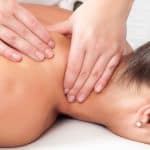Often forgotten by bodyworkers, strain counterstrain (SCS) is a positional release technique that is invaluable when working with clients experiencing acute muscular pain. Several professions have embraced SCS, and it is one of the first applications therapists can try to help someone with an extremely tender location that has a limited range of motion.
In the January 26, 2009 edition of ADVANCE for Physical Therapists and PT Assistants, Tom Dalonzo-Baker, PT describes how this positional release technique helped his client. According to Dalonzo-Baker, a patient scheduled for disc herniation surgery in four days entered his clinic bent over backward in agonizing back pain. He knelt down and allowed her body to relax, bent backward, over his knee. While thinking of how to best help her, he noticed that the woman’s posture relaxed. After several minutes, the woman stood erect for the first time in three weeks.
Dalonzo-Baker postulates that positioning her body further into the restriction allowed her to stand upright. Moving away from the restriction is thought to reduce aberrant afferent impulses sent to the spinal cord – and characterize the value of strain counterstrain technique.
About SCS
Strain counterstrain is a manual massage technique for relieving musculoskeletal spasms and pain. A positional release technique, SCS was developed in 1981 by the osteopathic physician Dr. Lawrence Jones. It is a gentle and safe technique that relieves spinal or other joint pain by passively shortening the affected muscle areas.
Repetitive or acute strains can lead to the development of painful tender spots. Dr. Jones identified the most common tender points that result from an abnormal reflex or unnatural movement. SCS focuses on correcting abnormal neuromuscular reflexes by finding the client’s position of comfort and determining at what point his/her tenderness diminishes. SCS involves:
- Having the client hold his/her position of comfort for approximately 90 seconds
- Then, the client is slowly brought out of this position, allowing the body to reset its muscles to a normal level of tension
- SCS is well-tolerated because it positions the recipient opposite his/her restricted barrier and towards the position of greatest comfort
An Explanation
Various scientists have offered explanations as to why SCS is so effective. Written in the 1970s, Irwin Korr’s work on muscle spindles and facilitated segments provides a solid rationalization for SCS. According to Korr, the counterstrain point is on the opposite side of a strained or suddenly stretched joint, otherwise known as the over-shortened side. The physiology that actually occurs on this side is a sudden shortening followed by a rapid return to normal length. On the strained side, the muscle spindles are recruited to protect the rapidly lengthening muscle from damage, creating an immediate reflex contraction. This muscle can then get stuck in a functionally shortened position.
During an SCS session, the practitioner palpates to identify active tender points related to hypertonic musculature. When the appropriate position is held during SCS, the muscles gain strength and diminish in tenderness. The proprioceptor nerves register the changes in the position of the muscle and enable it to remain in this neutral position even when the force applied by the practitioner has been removed.
Applications
In addition to restoring range of motion, strain counterstrain can help alleviate pain and discomfort in muscles and joints. Some examples of when to consider SCS for a client include:
- Post-injury pain
- Whiplash
- For a child or elderly person in pain
- Neck and back pain
- Fibromyalgia
Learning the strain counterstrain technique better equips massage therapists to help their clients overcome different kinds of pain. Designed to correct traumatically induced aberrant reflex changes that hold a dysfunctional muscular pattern, SCS is an excellent first choice for dealing with extreme discomfort. As witnessed in Dalonzo-Baker’s client with back pain, finding someone’s most comfortable position can bring them the breakthrough relief they are hoping to find.
Recommended Study:
Fibromyalgia and Massage
Myofascial Release
Sports Massage
More Information:
Acute Pain: Description and Massage Precautions















